About This Guide
This guide is a complementation of Quick Installation Guide. The Quick Installation Guide instructs you on quick Internet setup, and this guide provides details of each function and shows you the way to configure these functions appropriate to your needs.
When using this guide, please notice that features of the router may vary slightly depending on the model and software version you have, and on your location, language, and Internet service provider. All screenshots, images, parameters and descriptions documented in this guide are used for demonstration only.
Conventions
In this guide, the following conventions are used:

More Info
- The latest software, management app and utility can be found at Download Center at http://www.tp-link.com/support.
- The Quick Installation Guide (QIG) can be found where you find this guide or inside the package of the router.
- Specifications can be found on the product page at http://www.tp-link.com.
- A Technical Support Forum is provided for you to discuss our products at http://forum.tp-link.com.
- Our Technical Support contact information can be found at the Contact Technical Support page at http://www.tp-link.com/support.
Get to Know About Your Modem Router
This chapter introduces the modem router and shows its appearance.This chapter contains the following sections:
- Product Overview
- Product Appearance
1.1. Product Overview
TP-LINK’s Cable Modem Router is a combined wired/wireless network connection device with integrated wireless router and DOCSIS 3.0 modem, reducing hassle of configuration and saving space.With Ethernet ports and antennas, the modem router provides wired and wireless access for multiple computers and mobile devices.With various features and functions, the modem router is the perfect hub of your home or business network.
1.2. Product Appearance
1.2.1. Front Panel

The front panel provides LEDs. You can check the modem router’s working status by following the LED Explanation table.


Note:
- If the Downstream LED or Upstream LED is off, check your Internet connection first. Refer to Connect Your Modem Router for more information about how to make Internet connection correctly. If you have already made a right connection, contact your ISP to make sure your Internet service is available now.
- If the Internet LED is off, check your Downstream LED and Upstream LED first. If they are also off, please refer to Note 1. If the downstream LED and Upstream LED are ON, check your Internet configuration. You may need to check this part of information with your ISP and make sure everything have been input correctly.
1.2.2. Back Panel

The back panel provides buttons and connection ports. Refer to the following for detailed instructions.

Quick Start
This chapter contains the following sections:
- Position Your Modem Router
- Connect Your Modem Router
- Activate Your Modem Router
2.1. Position Your Modem Router
With the modem router, you can access your network from anywhere within the wireless network coverage. However, the wireless signal strength and coverage vary depending on the actual environment of your modem router. Many obstacles may limit the range of the wireless signal, for example, concrete structures or thick walls.For your safety and best Wi-Fi performance, please:
- Do Not locate the modem router in the place where it will be exposed to moisture or excessive heat.
- Keep away from the strong electromagnetic radiation and the device of electromagnetic sensitive.
- Place the modem router where it can be connected to the various devices as well as to a power source.
- Make sure the cables and power cord are safely placed out of the way to avoid a tripping hazard.Tips: The modem router can be placed on a shelf or desktop.
2.2. Connect Your Modem Router
Before connecting the device, please make sure your broadband cable service provided by your ISP is available. If there is any problem, please contact your ISP. Also, keep your hands dry during connection. Follow the steps below to connect your modem router.
- Connect the coaxial cable and power adapter to the modem router, then power on your modem router.

2 Wait for about 1 minute until the following LEDs are solid on.
![]()
3 Connect your computer to the modem router.
Method 1: WiredConnect your computer’s Ethernet port to a LAN port on the modem router via an Ethernet cable.
Method 2: WirelessConnect wirelessly by using the default SSID (Wireless Network Name) and Wireless Password printed on the product label of the modem router.
Method 3: Use the WPS buttonWireless devices that support WPS, including Android phones, tablets, most USB network cards, can be connected to your router through this method. (WPS is not supported by iOS devices.)Note:The WPS function cannot be configured if the wireless function of the modem router is disabled. Also, the WPS function will be disabled if your wireless encryption is WEP. Please make sure the wireless function is enabled and is configured with the appropriate encryption before configuring the WPS.
- Tab the WPS icon on the device’s screen.
- Immediately press the WPS button on your modem router.
- The WPS LED flashes for about two minutes during the WPS process.
- When the WPS LED is on, the client device has successfully connected to the modem router.

2.3, Activate Your Modem Router
1. Get your Internet service account information and the modem router’s Information Card ready.
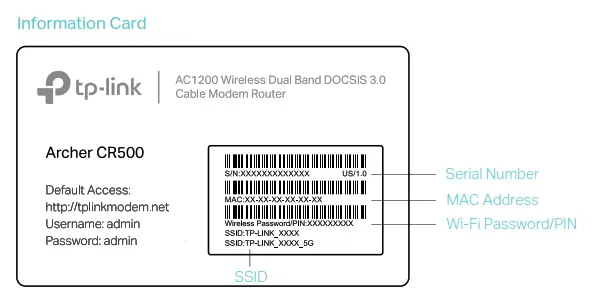
2. Make sure your computer is set to dynamically obtain an IP address. If not, refer to Appendix: Troubleshooting for instructions.3. Launch a web browser, and visit any website. You will be automatically redirected to your service provider’s self-activation page.4. Follow the on-screen self-activation instructions to activate the modem router.If you have any problem activating your modem router, call your ISP’s customer service .

5. After activating your modem router successfully, wait for about 10 minutes till these LEDs ![]() become solid on, then you can enjoy the Internet.Note:
become solid on, then you can enjoy the Internet.Note:
- If you are unable to access the Internet, refer to Appendix: Troubleshooting > T4 for instructions.
- The product should be connected to cable distribution system that grounded (earthed) in accordance with ANSI/NFPA 70, the National Electrical Code (NEC), in particular Section 820.93 – Grounding of Outer Conductive Shield of a Coaxial Cable.
Log into Your Modem Router
With a web management page, it is easy to configure and manage the modem router. The web management page can be used on any Windows, Macintosh or UNIX OS with a Web browser, such as Microsoft Internet Explorer, Mozilla Firefox or Apple Safari.
Follow the steps below to log into your modem router.
- If the TCP/IP Protocol on your computer is set to the static (fixed) IP address, you need to change it to obtain an IP address automatically. Refer to Appendix: Troubleshooting > T7 to configure your computer.
- Launch a web browser and go to http://tplinkmodem.net or http://192.168.1.1. Use admin for both username and password, then click Log in.

Note: If the login page does not appear, please refer to Appendix: Troubleshooting > T3.
Configure Internet Connections
This chapter introduces how to manually configure your Internet settings. Furthermore, you can also set up an IPv6 connection if your ISP provides IPv6 service. This chapter includes the following sections:
- Set Up an IPv6 Connection
- Test Internet Connectivity
- More Operation Modes
4.1. Set Up an IPv6 Connection
If your ISP has provided a line that supports IPv6 connection as well as some detailed IPv6 parameters, you can manually set up an IPv6 connection.Follow the steps below to set up an IPv6 connection:
- Make sure you have set up an IPv4 connection by referring to Quick Start before setting up an IPv6 connection.
- Visit http://tplinkmodem.net, and log in with the username (admin) and password (admin or the one customized by you).
- Go to Advanced > Network > IPv6 LAN Settings. In the DHCPv6 Server Settings section, configure the following parameters provided by your ISP.

- DHCPv6 Server: Select the checkbox to enable DHCPv6 server.
- Start Address: Enter a value for the DHCPv6 server to start with when issuing IP addresses.
- Number of addresses: Enter a value between 0-255 for DHCPv6 server preference. The default value is 255.
- Valid Lifetime: The Valid Lifetime is the amount of time in which a network user will be allowed connection to the modem router with their current dynamic IP address. Enter the amount of time, in seconds, then the user will be assigned this dynamic IP address. After the dynamic IP address has expired, the user will be automatically assigned a new dynamic IP address. The default is 3600 seconds.
- Rapid Commit: Select the checkbox to enable the prefix fast distribution function.
- Unicast: Select the checkbox to enable the unicast function. The default setting is disabled.
- Stateless DHCPv6: Stateless DHCPv6 is a combination of “stateless Address Autoconfiguration” and “Dynamic Host Configuration Protocol for IPv6” and is specified by RFC3736. Select the checkbox to enable this function.
4 Click Save to make the settings effective. Now IPv6 service is available for your network.
4.2. Test Internet Connectivity
After manually setting up the Internet connection, you need to test the Internet connectivity. The modem router provides two diagnostic tools to help you locate the malfunction.
- Visit http://tplinkmodem.net, and log in with the username (admin) and password (admin or the one customized by you).
- Go to Advanced > System Tools > Diagnostics.

3. Select Ping or Traceroute as the Diagnostic tool and enter the parameters according to your needs.
- Ping is used to test the connectivity between the router and the tested host, and measure the round-trip time.IP Address: Enter the IP address that you want to ping.Ping Packet Size: Enter the size of the ping packet you want to use.Ping Count: Enter the number of times you want to ping the target device.Ping Interval: Enter the time period between each ping.
- Traceroute is used to display the route (path) your router has passed to reach the tested host, and measure transit delays of packets across an Internet Protocol network.IP Address/ Domain Name: Enter the IP Address or Domain Name you want to trace.Max Hops: Enter the max number of hops.Data Size: Enter the size of data you want to use.Base Port: Enter the port number to send packets.Resolve Host: To resolve the host name to the IP address you can select ON from the drop-down list. The default status is OFF.
4. Click Start Test to check the connectivity of the Internet. The page will display the result of diagnosis.
Tips:
- (For Ping only) Click Abort Test to end the connectivity of the Internet.
- Click Clear Results to delete the logs.
4. 3. More Operation Modes
The modem router supports two operation modes: Router Mode and Bridge Mode. The modem router uses the Router Mode by default, and you can change the mode according to your needs.

4. 3. 1. Bridge Mode
In this mode, the modem router can be configured to act as a bridging device between your LAN and your ISP. Bridges are devices that enable two or more networks to communicate as if they are two segments of the same physical LAN. If you were in Bridge Mode, change the computer setting to obtain an IP address automatically. You could log into the web management page at 192.168.100.1.
Network Security
This chapter guides you on how to protect your home network from unauthorized users by implementing the following network security functions. You can control certain client devices’ access to the Internet, block certain data from getting through your network, and get notified when a threat emerges or view log events.
- Control Clients’ Access
- Use Firewall
- Email Local Log
- Record Log in a Remote Server
5.1. Control Clients’ Access
With the following functions,you can control wireless client devices’ access to the Internet by Wireless MAC Filtering; you can also deny clients’ access by using clients’ IP address, MAC address and port number; meanwhile, you can allow clients’ access by configuring Passthrough Options..
5.1.1. Wireless MAC Filtering
This function exploits the uniqueness of the MAC (Medium Access Control) address, a unique 12-digit hexadecimal address (for example, D8:5D:4C:B4:46:EA) of every network device, to determine if the device can or cannot access your wireless network.
I want to:
Prevent unauthorized users from accessing my wireless network by utilizing the network device’s MAC address.
For example, I have a computer that is connected to my wireless network. Now, an unknown device (an intruder) is also using my wireless network, which affects my Internet speed. I would like to control my wireless network with the following capabilities:
• My computer is always allowed to access the wireless network.• The unknown device is not allowed to access the wireless network.• I don’t have to keep changing my wireless password as often.
How can I do that?
- Visit http://tplinkmodem.net, and log in with the username (admin) and password (admin or the one customized by you).
- Go to Advanced > Wireless 2.4G or Wireless 5G > MAC Filtering.
- Select the wireless interface you want to configure and enable MAC Filtering.

4 Select the filtering rule to either block (recommended) or allow the device(s) in the list.
To block/allow specific device(s)
- Select Block List (All devices in this list can not access this router.) or Allow List (Only device in this list can access this router.) and click Save.
- Click Add.
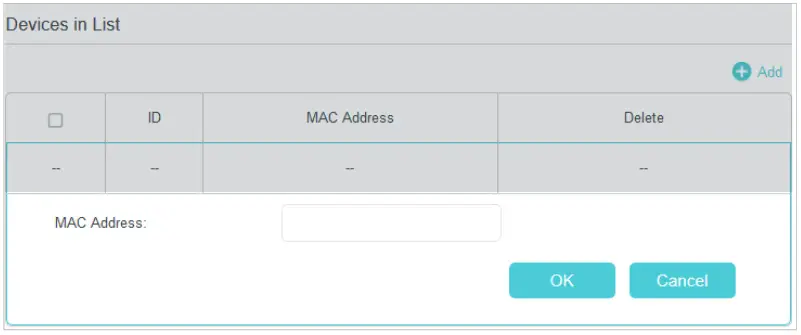
3 ) Enter the MAC Address manually.4 ) Click OK.
Done! – Now MAC Filtering is implemented to protect your wireless network.
5.1.2. Deny Access By IP Address
If you want to deny clients’ access by IP address, follow the steps below to configure IP Filtering:
- Visit http://tplinkmodem.net, and log in with the username (admin) and password (admin or the one customized by you).
- Go to Advanced > NAT Forwarding > IP Filtering, click Add.

- Enter the Start IP and End IP of the clients that cannot access this router. For example, clients with the IP address of 192.168.1.20 to 192.168.1.30 cannot access the router.
- Select Enable this Entry.
- Click OK to save the settings.
5.1.3. Deny Access By MAC Address
If you want to deny clients’ access by MAC address, follow the steps below to configure MAC Filtering:
- Visit http://tplinkmodem.net, and log in with the username (admin) and password (admin or the one customized by you).
- Go to Advanced > NAT Forwarding > MAC Filtering, click Add.

- Enter the MAC Address of the client that cannot access this router. For example, clients with the MAC address of 00:23:45:67:89:AB cannot access the router.
- Click OK to save the settings.
5.1.4. Deny Access By Port Number
If you want to deny access by using port numbers, follow the steps below to configure Port Filtering:
- Visit http://tplinkmodem.net, and log in with the username (admin) and password (admin or the one customized by you).
- Go to Advanced > NAT Forwarding > Port Filtering, click Add.

- Enter the Start Port and End Port to deny access. Packets whose destination port is within the specified port range will not be transmitted to the WAN side. For example, if Start Port is 1 and End Port is 35, packets destined to Port 1 to Port 35 will all be denied.
- Select the Protocol used for the specified ports, either TCP, UDP, or Both (all protocols supported by the modem router).
- Select Enable this entry.
- Click OK to save the settings.
5.1.5. Allow Access By Passthrough Options
Passthrough Options allow specific services and clients to pass through the modem router.> To allow specific services to pass through the modem router:
- Visit http://tplinkmodem.net, and log in with the username (admin) and password (admin or the one customized by you).
- Go to Advanced > NAT Forwarding > Options.
- Follow the explanations to enable the corresponding options. It is recommended to keep the default settings.
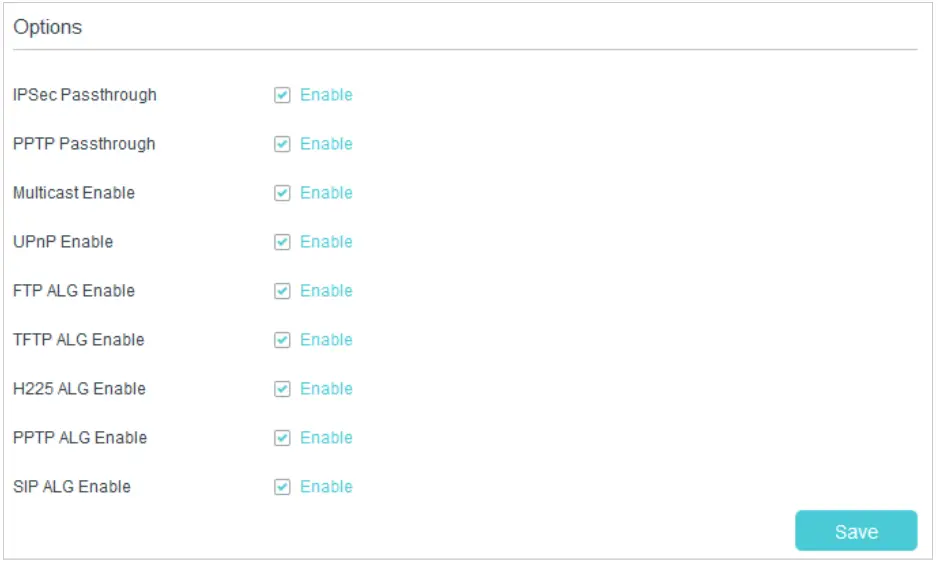
- IPSec Passthrough: Internet Protocol Security (IPSec) is a suite of protocols for ensuring private, secure communications over Internet Protocol (IP) networks, through the use of cryptographic security services. To allow IPSec tunnels to pass through the modem router, enable IPSec Passthrough.
- PPTP Passthrough: Point-to-Point Tunneling Protocol (PPTP) allows the Point-to-Point Protocol (PPP) to be tunneled through an IP network. To allow PPTP tunnels to pass through the modem router, enable PPTP Passthrough.
- Multicast Enable: Multicasting allows a single transmission to simultaneously reach specific within your local network. Select the checkbox to enable multicasting.
- UPnP Enable: UPnP (Universal Plug and Play) protocol allows the applications or host devices in the both sides of NAT device can freely communicate with each other realizing the seamless connection of the network. You may need to enable the UPnP if you want to use applications for multiplayer gaming, peer-to-peer connections, realtime communication (such as VoIP or telephone conference) or remote assistance,etc. Select the checkbox to enable UPnP. This feature is enabled by default.
- FTP ALG Enable: To allow FTP clients and servers to transfer data across NAT, enable FTP ALG Enable.
- TFTP ALG Enable: To allow TFTP clients and servers to transfer data across NAT, enable TFTP ALG Enable.
- H225 ALG Enable: To allow H225 clients and servers to transfer data across NAT, enable H225 ALG Enable.
- PPTP ALG Enable: To allow PPTP clients and servers to transfer data across NAT, enable PPTP ALG Enable.
- SIP ALG Enable: To allow SIP clients and servers to transfer data across NAT, enable SIP ALG Enable.
4 Click Save.> To allow specific clients to pass through the modem router:
- Visit http://tplinkmodem.net, and log in with the username (admin) and password (admin or the one customized by you).
- Go to Advanced > NAT Forwarding > Options, and find the PassThrough Mac Addresses section.
- Enter the MAC Address of the client whose IP address is assigned directly by the server PC instead of the NAT gateway on the router.
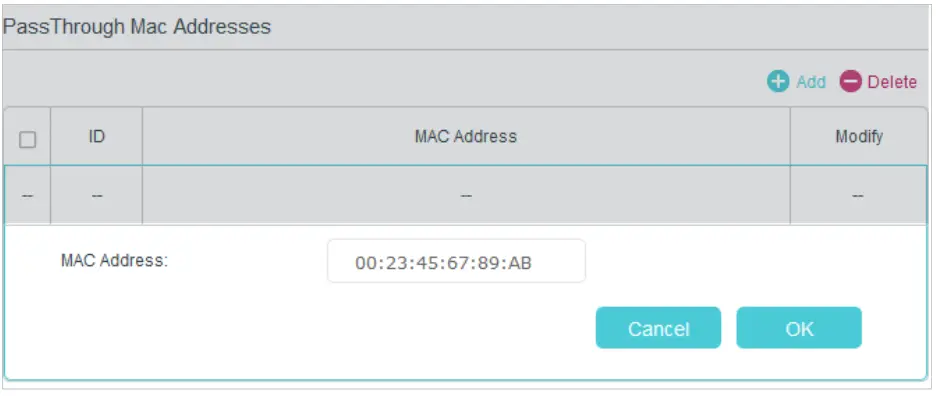
4 Click OK to save the settings.
5. 2. Use Firewall
- Visit http://tplinkmodem.net, and log in with the username (admin) and password (admin or the one customized by you).
- Go to Advanced > Firewall > Basic.
- Configure the basic firewall settings according to the following explanations:

- Firewall Protection: Select the firewall protection level appropriate to your needs. All the allowed services will be shown in the Allowed Services section according to the Firewall Protection level you select.
- Block Fragmented IP Packets: This feature helps to protect your private local network from Internet based denial of service attacks. Select the checkbox to enable this feature.
- Port Scan Detection: This feature can protect your private local network from Internet based hackers who attempt to gain unsolicited access to your network by detecting open IP ports on your gateway. Select the checkbox to enable this feature.
4 Click Save.
5. 3. Email Local Log
Local Log is used to send log to an email and you can analyze the logs as long as you have access to the email.Follow the steps below to email local log:
- Visit http://tplinkmodem.net, and log in with the username (admin) and password (admin or the one customized by you).
- Go to Advanced > Firewall > Local Log.

- Enter your email address in the Contact Email Address field.
- Enter the name of your SMTP sever in the SMTP Server Name field.
- Enter the default admin/admin or specify new username and password in the SMTP User Name and SMTP Password fields.
- If you want to get notified when your network is being attacked, enable E-mail Alerts.
- Click Email Log and the log will be immediately sent to the email you set.
Tips:
- The table displays details of the log.
- Click Clear Log to delete all the log.
5. 4. Record Log in a Remote Server
Remote Log allows you to record specific kinds of log in a remote server. The remote server must be in the local network.Follow the steps below to record log in a remote server:
- Visit http://tplinkmodem.net, and log in with the username (admin) and password (admin or the one customized by you.
- Go to Advanced > Firewall > Remote Log.

- Select the checkbox to record the corresponding events in the remote server.
- Enter the specified IP address of the remote system log server in the Server Address field.
- Click Save to make the settings effective.
USB Settings
This chapter describes how to share and access USB devices connected to the modem router among different clients.The modem router supports USB external flash drives, hard drives and USB printers.This chapter contains the following sections:
- Local Storage Sharing
- Remote Access via FTP Server
- Media Sharing
- Printer Sharing
6. 1. Local Storage Sharing
Share your USB storage devices with different users on the network.
6. 1. 1. Access the USB Disk
- Connect Your USB DiskInsert your USB storage device into the modem router’s USB port directly or using a USB cable. Wait several seconds until the USB LED becomes solid on.Tips:• If you use USB hubs, make sure no more than 4 devices are connected to the modem router.• If the USB storage device requires using bundled external power, make sure the external power has been connected.• If you use a USB hard drive, make sure its file system is FAT32 or NTFS.• Before you physically disconnect a USB device from the modem router, safely remove it to avoid data damage: Go to Advanced > USB Settings > Disk Settings and click

- Access Your USB DiskBy default, all the network clients can access all folders on your USB disk. Refer to the following table for access instructions. You can also customize your sharing content and set a sharing account by referring to Customize Your Settings.

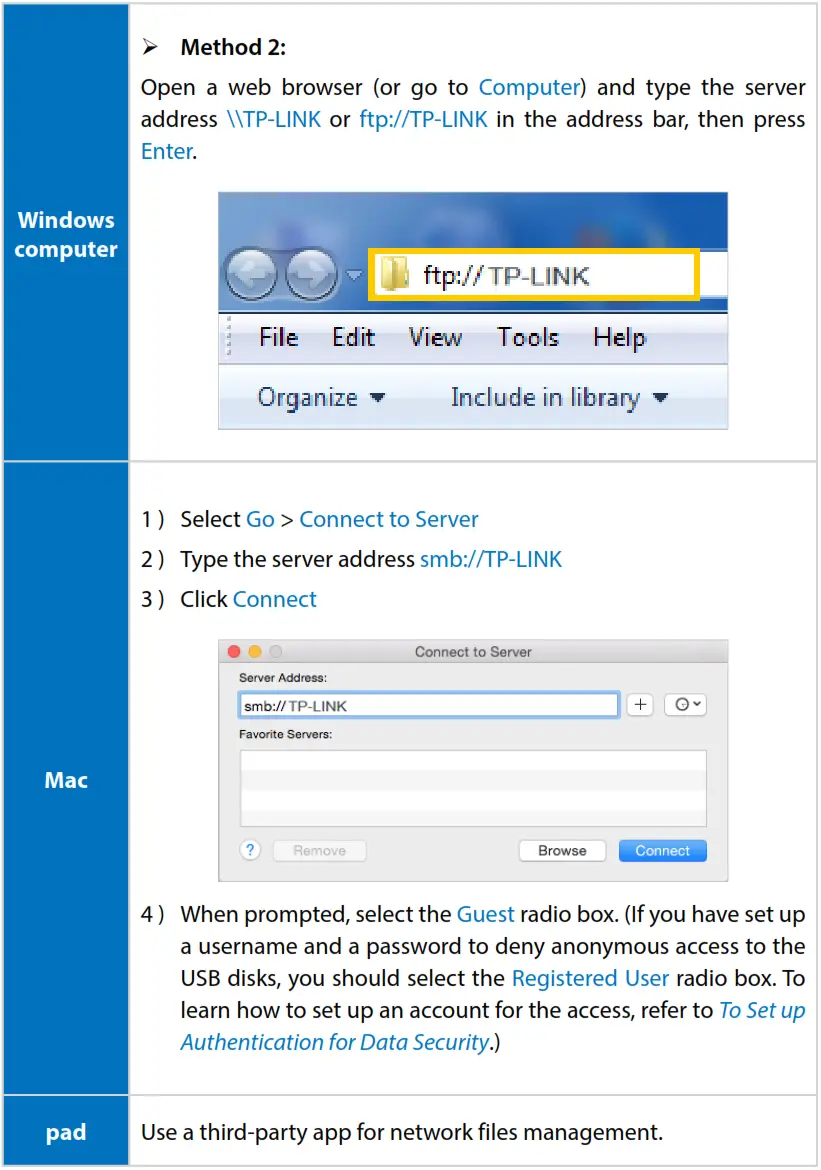
Tips:You can also access your USB disk by using your Network/Media Server Name as the server address. Refer to To Customize the Address of the USB Disk to learn more.
6. 1. 2. Customize Your Settings
>To Only Share Specific ContentBy default, Share All is enabled so all content on the USB disk is shared. If you want to only share specific folders, follow the steps below:
- Visit http://tplinkmodem.net, then log in with the username (admin) and password (admin or the one customized by you).
- Select Basic > USB Settings > Folder Sharing. Focus on the Sharing Folders section. Click the button to disable Sharing All, then click Add to add a new sharing folder.
- Select the Volume and Folder Path, then enter a Share Name as you like.
- Decide the way you share the folder:• Enable Authentication: Tick to enable authentication for this folder sharing, and you will be required to use a username and password to access the USBdisk. Refer to To Set up Authentication for Data Security to learn more.• Write Access: If you tick this checkbox, network clients can modify this folder.• Enable Media Sharing: Tick to enable media sharing for this folder, and you can view photos, play music and watch movies stored on the USB disk directly from DLNA-supported devices. Click Media Sharing to learn more.
- Click OK.
Tips:The modem router can share eight volumes at most. You can click ![]() on the page to detach the corresponding volume you do not need to share.
on the page to detach the corresponding volume you do not need to share.

> To Set up Authentication for Data SecurityIf you enable Authentication, network clients will be required to enter the usernameand password you set when accessing the USB disk.
-
- Visit http://tplinkmodem.net, then log in with the username (admin) and password (admin or the one customized by you).
- Select Advanced > USB Settings > Folder Sharing.

- Choose to use the default Account (admin) or use a new account and click Save.Note:For Windows users, do not set the sharing username the same as the Windows username. Otherwise, Windowscredential mechanism may cause the following problems:
-
-
- If the sharing password is also the same as the Windows password, authentication will not work since the Windows will automatically use its account information for USB access.
- If the sharing password is different from the Windows password, the Windows will be unable to remember your credentials and you will always be required to enter the sharing password for USB access.
-
4. Enable Authentication to apply the account you just set.
-
-
- If you leave Sharing All enabled, click the button to enable Authentication for all folders.
-

Note:Due to Windows credential mechanism, you might be unable to access the USB disk after changing Authentication settings. Please log out from the Windows and try to access again. Or you can change the address of the USB disk by referring to To Customize the Address of the USB Disk.
> To Customize the Address of the USB DiskYou can customize the server name and use the name to access your USB disk.
- Visit http://tplinkmodem.net, then log in with the username (admin) and password (admin or the one customized by you).
- Select Advanced > USB Settings > Folder Sharing.
- Make sure Network Neighborhood is ticked, and enter a Network/Media Server Name as you like, such as MyShare, then click Save.

- Now you can access the USB disk by visiting \\MyShare (for Windows) or smb:// MyShare (for Mac).
6. 2. Remote Access via FTP Server
You can access your USB disk outside the local area network.For example:
- Share photos and other large files with your friends without logging in to (and paying for) a photo-sharing site or email system.
- Get a safe backup for the materials for a presentation.
- Remove the files on your camera’s memory card from time to time during the journey.Note:If your ISP assigns a private WAN IP address (such as 192.168.x.x or 10.x.x.x), you cannot use this feature because private addresses are not routed on the Internet.
6. 2. 1. Access the USB Disk
- Connect Your USB DiskInsert your USB storage device into the modem router’s USB port directly or using a USB cable. Wait several seconds until the USB LED becomes solid on.
Tips:
- If you use USB hubs, make sure no more than 4 devices are connected to the modem router.
- If the USB storage device requires using bundled external power, make sure the external power has been connected.
- If you use a USB hard drive, make sure its file system is FAT32 or NTFS.
- Before you physically disconnect a USB device from the modem router, safely remove it to avoid data damage: Select Advanced > USB Settings > Disk Settings and click
 .
.
2 Enable Authentication for Data SecurityIt is strongly recommended that you set and apply a sharing account for data security.
-
- Visit http://tplinkmodem.net, then log in with the username (admin) and password (admin or the one customized by you).
- Select Advanced > USB Settings > Folder Sharing.
- Choose to use the default Account (admin) or use a new account and click Save.
 Note:For Windows users, do not set the sharing username the same as the Windows username. Otherwise, Windows credential mechanism may cause the following problems:• If the sharing password is also the same as the Windows password, authentication will not work since the Windows will automatically use its account information for USB access.• If the sharing password is different from the Windows password, the Windows will be unable to remember your credentials and you will always be required to enter the sharing password for USB access.
Note:For Windows users, do not set the sharing username the same as the Windows username. Otherwise, Windows credential mechanism may cause the following problems:• If the sharing password is also the same as the Windows password, authentication will not work since the Windows will automatically use its account information for USB access.• If the sharing password is different from the Windows password, the Windows will be unable to remember your credentials and you will always be required to enter the sharing password for USB access. - Enable Authentication to apply the sharing account.• If Sharing All is disabled, enable Authentication for specific folders.
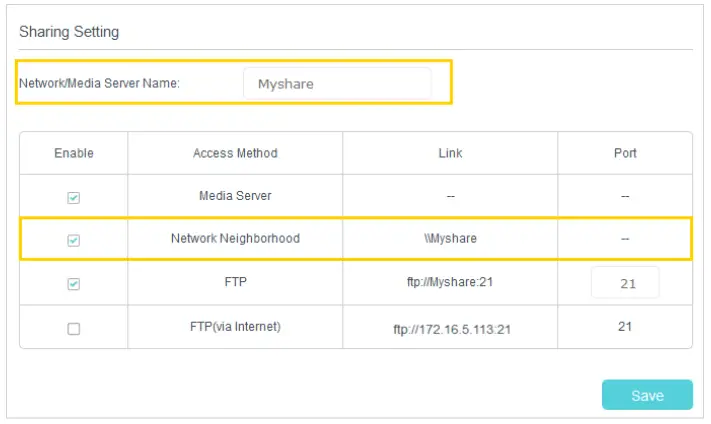
Note:Due to the Windows credential mechanism, you might be unable to access the USB disk after changing Authentication settings. Please log out from Windows and try to access it again.
3. Enable the FTP (via the Internet)Select the check box to enable FTP(via the Internet), then click Save.
4 Access Your USB Disk via Internet
Now different clients with Internet connection can access the USB disk:

Tips:Click Set Up a Dynamic DNS Service Account to learn how to set up a domain name for you modem router.
6. 2. 2. Customize Your Settings
To Only Share Specific ContentBy default, Sharing All is enabled so all content on the USB disk is shared. If you want to only share specific folders, follow the steps below:
- Visit http://tplinkmodem.net, then log in with the username (admin) and password (admin or the one customized by you).
- Select Basic > USB Settings > Folder Sharing. Focus on the section of Sharing Folders. Click the button to disable Sharing All, then click Add to add a new sharing folder.

- Select the Volume and Folder Path, then specify the Share Name as you like.
- Tick Enable Authentication.
- If you allow network clients to modify this folder, tick Write Access.
- Click OK.
Tips:The modem router can share eight volumes at most. You can click on the page to detach the corresponding volume you do not need to share.

6. 3. Media Sharing
The feature of Media Sharing allows you to view photos, play music and watch movies stored on the USB disk directly from DLNA-supported devices, such as your computer, pad and PS2/3/4.
6. 3. 1. Access the USB Disk
1 Connect Your USB Disk
Insert your USB storage device into the modem router’s USB port directly or using a USB cable. Wait several seconds until the USB LED becomes solid on.
Tips:
- If you use USB hubs, make sure no more than 4 devices are connected to the modem router.
- If the USB storage device requires using bundled external power, make sure the external power has been connected.
- If you use a USB hard drive, make sure its file system is FAT32 or NTFS.
- Before you physically disconnect a USB device from the modem router, safely remove it to avoid data damage: Go to Advanced > USB Settings > Disk Settings and click
 .
.
2 Access the Media Files on Your USB Disk
Now the DLNA-supported devices (such as your computer and pad) connected to the modem router can detect and play the media files on the USB disks.

6. 3. 2. Customize Your Settings
To Only Share Specific ContentBy default, Sharing All is enabled so all content on the USB disk is shared. If you want to only share specific folders, follow the steps below:
- Visit http://tplinkmodem.net, then log in with the username (admin) and password (admin or the one customized by you).
- Select Basic > USB Settings > Folder Sharing.
- Focus on the section of Sharing Folders. Click the button to disable Sharing All, then click Add to add a new sharing folder.

- Select the Volume and Folder Path, then enter a Share Name as you like.
- Tick Enable Media Sharing and click OK.Tips:The modem router can share eight volumes at most. You can click
 on the page to detach the corresponding volume you do not need to share.
on the page to detach the corresponding volume you do not need to share.
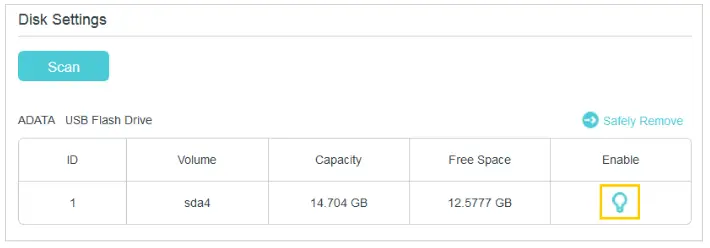
> To Specify the Media ServerYou can also modify the media server name or disable the feature of Media Sharing as needed.
- Visit http://tplinkmodem.net, then log in with the username (admin) and password (admin or the one customized by you).
- Select Advanced > USB Settings > Folder Sharing.
- Enter a Network/Media Server Name as you like, such as MyShare. You can deselect the checkbox of Media Server to disable the media server feature.

- Click Save.
6. 4. Printer Sharing
The feature of Printer Sharing helps you share a printer with different computers connected to the modem router.Note:Printers unlisted on this page may be incompatible with the modem router: http://www.tp-link.com/common/compatible/print-server/.
- Install the Driver of the PrinterMake sure you have installed the driver of the printer on each computer that needs printer service.If you do not have the driver, contact the printer manufacturer.
- Connect the PrinterCable a printer to the USB port with the USB cable. Wait several seconds until the USB LED becomes solid on.
- Install the TP-LINK USB Printer Controller UtilityTP-LINK USB Printer Controller Utility helps you access the shared printer. Download and Install the utility on each computer that needs printer service.1 ) Visit http://www.tp-link.com/app/usb/.2 ) Click PC Utility (for Windows users) or Mac Utility to download the installation file and uncompress it.
 3 ) Open the uncompressed folder, then click TP-LINK USB Printer Controller Setup (for Windows users) or TP-Link UDS Printer Controller Installer (for Mac users) to install the utility.
3 ) Open the uncompressed folder, then click TP-LINK USB Printer Controller Setup (for Windows users) or TP-Link UDS Printer Controller Installer (for Mac users) to install the utility. - Access the PrinterYou should set the shared printer as Auto-Connect Printer on every computer that needs printer service.1 ) Double-click the icon
 on your desktop to launch the USB Printer Controller.2 ) Highlight the printer you share.
on your desktop to launch the USB Printer Controller.2 ) Highlight the printer you share.
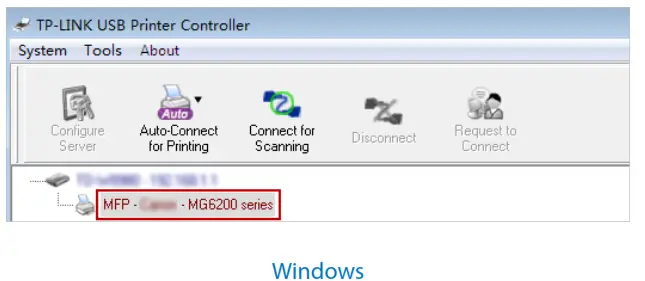
Mac3 ) Click the Auto-Connect for printing tab to pull down a list, then select Set Auto Connect Printer.
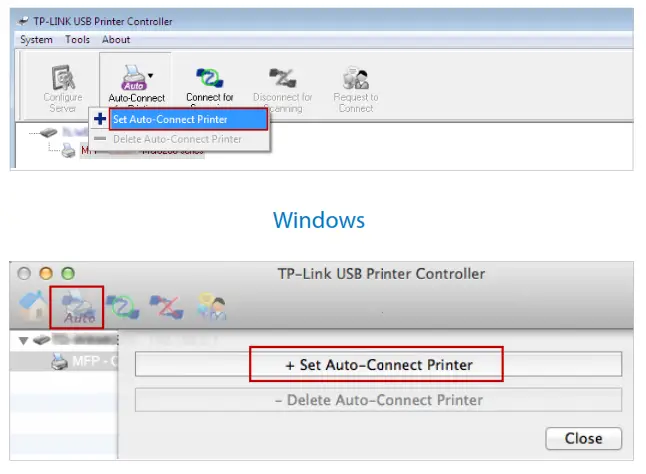
Mac4 ) Select the printer you share, then click Apply.
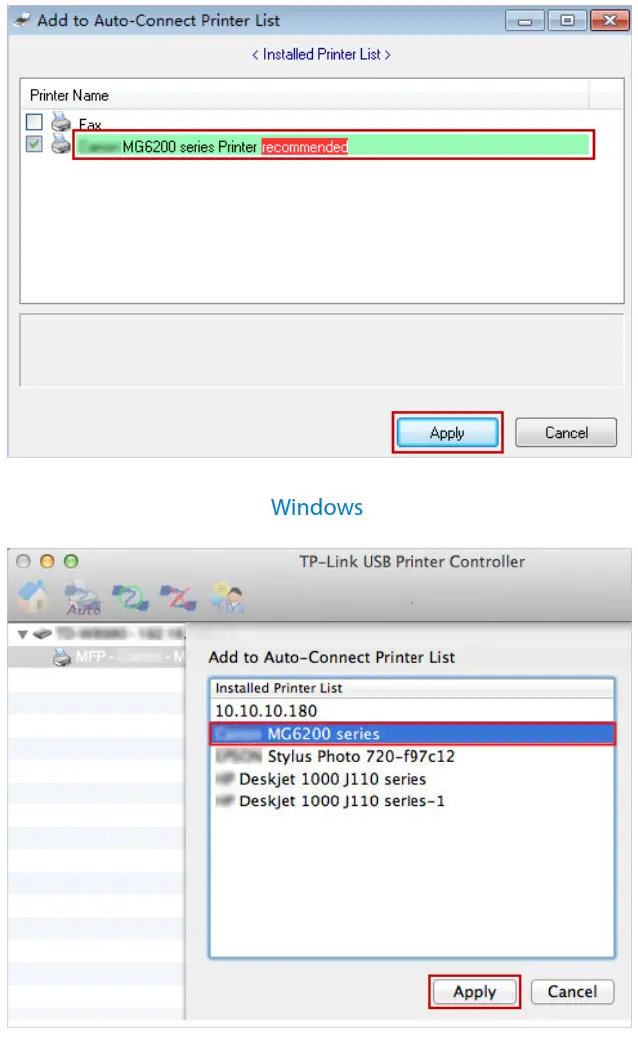
Mac5 ) You will see the printer marked as Auto-Connect Printer. Now you can print with this printer.

Mac
Tips:The Print Server also allows different clients to share the scan feature of MFPs (Multi-Function Printers). To scan with TP-LINK USB Printer Controller, right-click the printer and select Network Scanner. Then, a scanning window will pop up. Finish the scanning process by following the on-screen instructions.
Parental Control
This function allows you to block inappropriate, explicit and malicious websites, and control access to specified websites at specified time.
I want to:
Control what types of websites my children or other home network users can visit and even the time of day they are allowed to access the Internet.For example, I want to allow my children’s devices (e.g. a computer or a tablet) to access only www.tp-link.com and wikipedia.org from 18:00 (6PM) to 22:00 (10PM) on weekdays and not other time.
How can I do that?
-
- Visit http://tplinkmodem.net, and log in with the username (admin) and password (admin or the one customized by you).
- Go to Basic or Advanced > Parental Control and enable Parental Control.

3 Click Add.
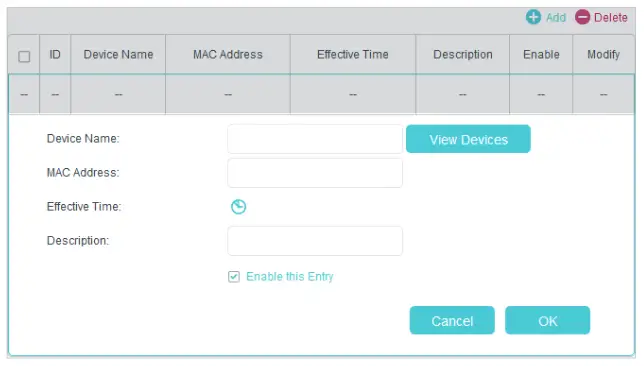
4 Click View Devices, and select the device to be controlled. Or, enter the Device Name and MAC Address manually.5 Click the ![]() icon to set the Effective Time. Select the appropriate cell(s) and click OK.
icon to set the Effective Time. Select the appropriate cell(s) and click OK.

6 Enter a Description for the entry.7 Select the checkbox to enable this entry and click OK.8 Select the restriction mode.
1 ) In Black List Mode, the controlled devices cannot access any websites containing the specified keywords during the Effective Time period.
2 ) In White List Mode, the controlled devices can only access websites containing the specified keywords during the Effective Time period.

9 Click Add a New Keyword. You can add up to 200 keywords for both Black List and White List. Below are some sample entries to allow access.
1 ) Enter a web address (e.g. www.tp-link.com) or a web address keyword (e.g. wikipedia) to only allow or block access to the websites containing that keyword.2 ) If you wish to block all Internet browsing access, do not add any keyword to the White List.
10 Enter the keywords or websites you want to add and click Save.Done! Now you can control your children’s Internet access according to your needs.
Guest Network
This function allows you to provide Wi-Fi access for guests without disclosing your main network. When you have guests in your house, apartment, or workplace, you can create a guest network for them. In addition, you can assign network authorities and bandwidth for guests to ensure network security, privacy, and fluency.• Create a Network for Guests• Customize Guest Network Options
8. 1. Create a Network for Guests
- Visit http://tplinkmodem.net, and log in with the username (admin) and password (admin or the one customized by you).
- Go to Advanced > Wireless 2.4G/5G > Guest Network. Locate the Wireless section.
- Create a 2.4GHz or 5GHz guest network according to your needs.

1 ) Select Enable Guest Network.2 ) Set an easy-to-identify SSID. Don‘t select Hide SSID unless you want your guests and other people to manually input this SSID for Wi-Fi access.3 ) Set Security to WPA/WPA2 Personal, keep the default Version and Encryption values, and set an easy-to-remember password.4 Click Save. Now your guests can access your guest network using the SSID and password you set!Tips:To view guest network information, go to Advanced > Status and find the Guest Network section.
8. 2. Customize Guest Network Options
1 Visit http://tplinkmodem.net, and log in with the username (admin) and password (admin or the one customized by you).2 Go to Advanced > Wireless 2.4G/5G > Guest Network. Locate the Settings section.

3 Assign network authorities according to your needs.
• Allow guests to see each otherSelect this checkbox to allow the clients in your guest network to access each other.• Allow guests to access my local networkSelect this checkbox to allow the clients in your guest network to access your localnetwork, not just Internet access.
4 Click Save. Now users in your guest network can enjoy only the network authorities you assigned!
Tips:To view guest network information, go to Advanced > Status and find the Guest Network section.
NAT Forwarding
Modem router’s NAT (Network Address Translation) feature makes the devices in the LAN use the same public IP address to communicate in the Internet, which protects the local network by hiding IP addresses of the devices. However, it also brings about the problem that external host cannot initiatively communicate with the specified device in the local network.With forwarding feature the modem router can penetrate the isolation of NAT and allows the external hosts in the Internet to initiatively communicate with the devices in the local network, thus to realize some special functions.TP-LINK modem router includes three forwarding rules. If two or more rules are set, the priority of implementation from high to low is Port Forwarding, Port Triggers and DMZ.This chapter contains the following sections:• Share Local Resources in the Internet by Port Forwarding• Open Ports Dynamically by Port Triggers• Free Applications from Port Restriction by DMZ
When you build up a server in the local network and want to share it on the Internet, Port Forwarding can realize the service and provide it to the Internet users. At the same time Port Forwarding can keep the local network safe as other services are still invisible from the Internet.
Port Forwarding can be used for setting up public services in your local network, such as HTTP, FTP, DNS, POP3/SMTP and Telnet. Different service uses different service port. Port 80 is used in HTTP service, port 21 in FTP service, port 25 in SMTP service and port 110 in POP3 service. Please verify the service port number before the configuration.I want to: Share my personal website I’ve built in local network with my friends through the Internet.For example, the personal website has been built in my home PC (192.168.1.100). I hope that my friends in the Internet can visit my website in some way. The PC is connected to the modem router with the WAN IP address 218.18.232.154.
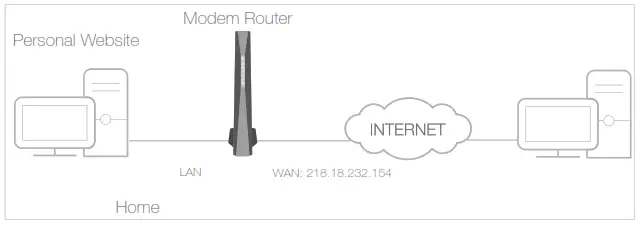
How can I do that?
1 Assign a static IP address to your PC, for example 192.168.1.100.2 Visit http://tplinkmodem.net, and log in with the username (admin) and password (admin or the one customized by you).3 Go to Advanced > NAT Forwarding > Port Forwarding, click Add.

4 Enter the service you want to use in Service Name field. Here we take HTTP as an example.5 Enter the External Port, Internal Port and select the corresponding Protocol as shown in the above picture.6 Enter the PC’s IP address 192.168.1.100 in the Internal IP field.7 Select Enable this Entry.8 Click OK to save the settings.
Tips:
1. You should verify the port number that the service needs.2. You can add multiple port forwarding rules if you want to provide several services in a modem router. Please note that the External Port cannot be overlapped.
Done! Users in the Internet can enter http:// WAN IP: External Port (in this example: http:// 218.18.232.154:80) to visit your personal website.Tips:1. WAN IP should be a public IP address. For the WAN IP is assigned dynamically by ISP, it is recommended to apply and register a domain name for the WAN by DDNS, go to Set Up a Dynamic DNS Service Account for more information. Then you can use http:// domain name: External Port to visit the website.
9. 2. Open Ports Dynamically by Port Triggers
Port triggers can specify a trigger port and its corresponding external ports. When a host in the local network initiates a connection to the trigger port, all the external ports will be opened for subsequent connections. The modem router can record the IP address of the host. When the data from the Internet return to the external ports, the modem router can forward them to the corresponding host. Port triggering is mainly applied to online games, VoIPs and video players. Common applications include MSN Gaming Zone, Dialpad and Quick Time 4 players, etc. Follow the steps below to configure the port trigger rules:
1 Visit http://tplinkmodem.net, and log in with the username (admin) and password (admin or the one customized by you).2 Go to Advanced > NAT Forwarding > Port Triggers and click Add.

3 Enter the name of the Application. Here we take application MSN Gaming Zone as an example.4 Enter the Trigger Start Port and Trigger End Port for outgoing traffic. An outgoing connection using this port will trigger this rule.5 Enter the External Start Port and External End Port used by the remote system when it responds to the outgoing request. A response using one of these ports will be forwarded to the PC which triggered this rule.6 Select the protocol used for the external ports, either TCP, UDP, or ALL (all protocols supported by the router).7 Select Enable this entry.8 Click OK to save the settings.
Note:1. When the trigger connection is released, the corresponding opened ports will be closed.2. Each rule can only be used by one host on the LAN at a time. The trigger connection of other hosts on the LAN will be refused.3. External Port ranges of different entries cannot overlap each other.
9. 3. Free Applications from Port Restriction by DMZ
When a PC is set to be a DMZ (Demilitarized Zone) host in the local network, it is totally exposed to the Internet. This can realize the unlimited bidirectional communication between internal hosts and external hosts. The DMZ host becomes a virtual server with all ports opened. When you are not clear about which ports to open in some special applications, like IP camera and database software, you can set the PC to be a DMZ host.
Note:DMZ is more applicable in the situation that users are not clear about which ports to open. When it is enabled, theDMZ host is totally exposed to the Internet, which may bring some potential safety hazard. If DMZ is not in use, please disable it in time.
I want to:
Make the home PC join the Internet online game without port restriction.For example, due to some port restriction, when playing the online games, you can log in normally but cannot join a team with other players. To solve this problem, set your PC as a DMZ with all ports opened.
How can I do that?
1 Assign a static IP address to your PC, for example 192.168.1.100.2 Visit http://tplinkmodem.net, and log in with the username (admin) and password (admin or the one customized by you).3 Go to Advanced > NAT Forwarding > DMZ.

Done!
4 Enter the IP address 192.168.1.100 in the DMZ Address field.5 Click Apply to save the settings.The configuration is completed. You’ve set your PC to a DMZ host and now you can make a team to game with other players.Tips:DMZ Address 192.168.1.0 indicates that DMZ is disabled.
Specify Your Network Settings
This chapter introduces how to change the default settings or adjust the basic configuration of the modem router using the web management page. This chapter contains the following sections:• Internet Settings• LAN Settings• Wireless Settings• Set Up a Dynamic DNS Service Account
10 1 Internet Settings
1 Visit http://tplinkmodem.net, and log in with the username (admin) and password (admin or the one customized by you).2 Go to Basic > Internet page. Select the Connection Type and enter the information provided by your ISP.Note: Do not change the settings unless necessary.

3 Click Apply to make the settings effective, and you can refer to Test Internet Connectivity to test the Internet connection.
10 2 LAN Settings
10 2 1 Change the LAN IP Address
The modem router is preset with a default LAN IP 192.168.1.1, which you can use to log in to its web management page. The LAN IP address together with the Subnet Mask (255.255.255.0) also defines the subnet that the connected devices are on. If the IP address conflicts with another device in your local network, you can change it. Follow the steps below to change your IP address.1 Visit http://tplinkmodem.net, and log in with the username (admin) and password (admin and the one customized by you).2 Go to Advanced > Network > LAN Settings page and locate the LAN Settings section.

3 Type in a new IP Address appropriate to your needs.4 Click Save in the DHCP Settings section to make the settings effective.
10 2 2 Use the Modem Router as a DHCP Server
You can configure the modem router to act as a DHCP server to assign IP addresses to its clients. To use the DHCP server function of the modem router, you must configure all computers on the LAN to obtain an IP Address automatically.Follow the steps below to configure DHCP server.1 Visit http://tplinkmodem.net, and log in with the username (admin) and password (admin or the one customized by you).2 Go to Advanced > Network > LAN Settings page and locate the DHCP Settings section.
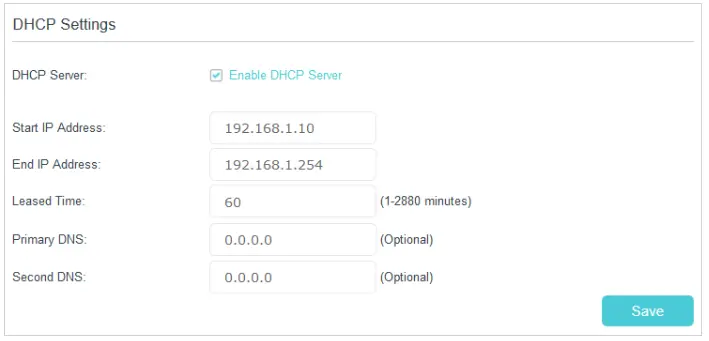
3 Select Enable DHCP Server to enable the DHCP function.4 Specify the Start IP Address and End IP Address which must be on the same subnet with the LAN IP. The modem router will assign addresses within this specified range to its clients. It is from 192.168.1.10 to 192.168.1.254 by default.5 Enter a value for the Leased Time. The Leased Time is the amount of time in which a DHCP client can lease its current dynamic IP address assigned by the modem router. After the dynamic IP address expires, the user will be automatically assigned a new dynamic IP address. The default is 60 minutes.6 Keep the rest of the settings as default and click Save.
10 3 Wireless Settings
10 3 1 Specify Basic Wireless SettingsThe modem router’s wireless network name (SSID) and password, and security option are preset in the factory. The preset SSID and password can be found on the product label. You can customize the wireless settings according to your needs. Visit http://tplinkmodem.net, and log in with the username (admin) and password (admin or the one customized by you). Go to Basic > Wireless page.

To enable or disable the wireless function:Enable the 2.4 GHz or 5GHz Wireless Network. If you don’t want to use the wireless function, just deselect the box. If you disable the wireless function, all the wireless settings won’t be effective.> To change the wireless network name (SSID) and wireless password:Enter a new SSID using up to 32 characters. The value is case-sensitive.Note:If you use a wireless device to change the wireless settings, you will be disconnected after the new settings are effective. Please write down the new SSID and password for future use.> To hide SSID:Select Hide SSID, and your SSID will not broadcast. Your SSID won’t display on your wireless device when you scan for local wireless network list and ou need to manually join the network.> To change the mode or channel:Go to Advanced > Wireless 2.4G or Wireless 5G > Basic Settings page.Power: Select the transmit power of the modem router. You can select 25%, 50%, 75% and 100% as you like. 100% is the default setting and is recommended.Mode: Select the desired mode.• 802.11n only: Select only if all of your wireless clients are 802.11n devices.• 802.11gn mixed: Select if you are using both 802.11g and 802.11n wireless clients.• 802.11bgn mixed: Select if you are using a mix of 802.11b, 11g, and 11n wireless clients.Note:When 802.11n only mode is selected, only 802.11n wireless stations can connect to the modem router. It is strongly recommended that you select 802.11bgn mixed, and all of 802.11b, 802.11g, and 802.11n wireless stations canconnect to the modem router.• 802.11ac only (5GHz): Select only if all of your wireless clients are 802.11ac devices.• 802.11ac/n mixed (5GHz): Select if you are using both 802.11ac and 802.11n wireless clients.• 802.11a/n/ac mixed (5GHz): Select if you are using a mix of 802.11a, 802.11n and 802.11ac wireless clients. It is strongly recommended that you select 11a/n/ac mixed.Channel: Select the channel you want to use from the drop-down list. This field determines which operating frequency will be used. It is not necessary to change the wireless channel unless you notice interference problems with another nearby access point.Bandwidth: Select the channel width from the drop-down list. The default setting is Auto for 2.4GHz wireless network and 80Mhz for 5GHz wireless network, which can adjust the channel width for your clients automatically.> To change the security option:1 Go to Wireless 2.4G or Wireless 5G > Primary Network page.2 Select an option from the Security drop-down list. The router provides four options, No Security, WPA/WPA2 Personal (Recommended), WPA/WPA2 Enterprise, WEP. WPA2 uses the newest standard and the security level is the highest. We don’t recommend you to change the default settings unless necessary.10 3 2 Use WPS for Wireless ConnectionYou can use WPS (Wi-Fi Protected Setup) feature to add a new wireless device to your existing network quickly.Method 1 Use the WPS ButtonUse this method if your client device has a WPS button.1. Press the WPS button on the modem router for 1 second.2. Press the WPS button of the client device directly.3. The WPS LED flashes for about 2 minutes during the WPS process.4. When the WPS LED is on, the client device has successfully connected to the modem router.Method 2 Enter the client device’s PIN on the modem router1. Visit http://tplinkmodem.net, and log in with the username (admin) and password (admin or the one customized by you).2. Go to Advanced > Wireless 2.4G or Wireless 5G > Primary Network page. Locate the WPS Wizard section.
3 Keep the default WPS status as Enabled and select the PIN Number radio button.4 Enter the client device’s PIN in the field on the above WPS screen. Then click the Connect button.5 Device has been added successfully will appear on the above screen, which means the client device has successfully connected to the modem router.
Method 3 Enter the modem router’s PIN on your client deviceUse this method if your client device asks for the modem router’s PIN.1 Visit http://tplinkmodem.net, and log in with the username (admin) and password (admin or the one customized by you).2 Go to Advanced > Wireless 2.4G or Wireless 5G > Primary Network page. Locate the Router’s PIN section.
3 Keep the Router’s PIN status as enabled. Take a note of the Current PIN of the modem router. You can also click the Generate button to get a new PIN.4 On the client device, enter the modem router’s PIN. (The default PIN is also printed on the label of the modem router.)5 The WPS LED flashes for about two minutes during the WPS process.6 When the WPS LED is on, the client device has successfully connected to the modem router.Note:1. The WPS LED on the modem router will light on for five minutes if the device has been successfully added to the network.2. The WPS function cannot be configured if the wireless function of the modem router is disabled. Please make sure the wireless function is enabled before configuring the WPS.
10 3 3 View Wireless Information> To view the detailed wireless network settings:1 Visit http://tplinkmodem.net, and log in with the username (admin) and password (admin or the one customized by you).2 Go to Advanced > Status page. You can see the Wireless box.3 Select 2.4GHz or 5GHz to view the wireless details.
Tips: You can also see the wireless details by clicking the router icon on Basic > Network Map.> To view the detailed information of the connected wireless clients:1 Visit http://tplinkmodem.net, and log in with the username (admin) and password (admin or the one customized by you).2 Go to Basic > Network Map page and click the Wireless Clients icon.3 You can view the detailed information of the wireless clients, including its name, IP address and MAC address.
10 3 4 Advanced Wireless SettingsAdvanced wireless settings are for those who have a network concept. If you are not familiar with the settings on this page, it’s strongly recommended that you keep the provided default values; otherwise it may result in lower wireless network performance.1 Visit http://tplinkmodem.net, and log in with the username (admin) and password (admin or the one customized by you).2 Go to Advanced > Wireless 2.4G or Wireless 5G > Wireless Advanced page.
• Beacon Interval: Enter a valu e between 25 and 1000 in milliseconds to determine the duration between which beacon packets are broadcasted by the router to synchronize the wireless network. The default is 100 milliseconds.• DTIM Interval: Enter a value between 1 and 255 to determine the interval of the Delivery Traffic Indication Message (DTIM). 1 indicates the DTIM Interval is the same as Beacon Interval.• Fragmentation Threshold: This value is the maximum size determining whether packets will be fragmented. Setting the Fragmentation Threshold too low may result in poor network performance because of excessive packets. 2346 is the default setting and is recommended.• RTS Threshold: Enter a value between 1 and 2347 to determine the packet size of data transmission through the router. By default, the RTS (Request to Send) Threshold size is 2347. If the packet size is greater than the preset threshold, the router sends Request to Send frames to a particular receiving station and negotiates the sending of a data frame, or else the packet will be sent immediately.• Short GI: This feature is enabled by default and recommended to increase the data capacity by reducing the Guard Interval (GI) time.• Enable WMM: This feature guarantees the packets with high-priority messages being transmitted preferentially. WMM is enabled compulsively under 802.11n or 802.11ac mode. It is strongly recommended to enable WMM.• Enable Power Save Support: Select the checkbox to enable this function. This function allows the router to keep only one antenna in working condition while the remaining antennas dormant, so as to achieve the purpose of saving power.3 Click Save to make the settings effective.
10. 4. Set Up a Dynamic DNS Service AccountMost ISPs (Internet service providers) assign a dynamic IP address to the router and you can use this IP address to access your router remotely. However, the IP address can change any time and you don’t know when it changes. In this case, you might need the DDNS (Dynamic Domain Name Server) feature on the router to allow you and your friends to access your router and local servers (FTP, HTTP, etc.) using domain name, in no need of checking and remembering the IP address.Note: DDNS does not work if the ISP assigns a private WAN IP address (such as 192.168.1.x) to the modem router.To set up DDNS, please follow the instructions below:1 Visit http://tplinkmodem.net, and log in with the username (admin) and password (admin or the one customized by you).2 Go to Advanced > Network > Dynamic DNS.3 Select the DDNS Service (Dyndns or NO-IP). If you don’t have a DDNS account, you need to register an account on the provider’s official website first.
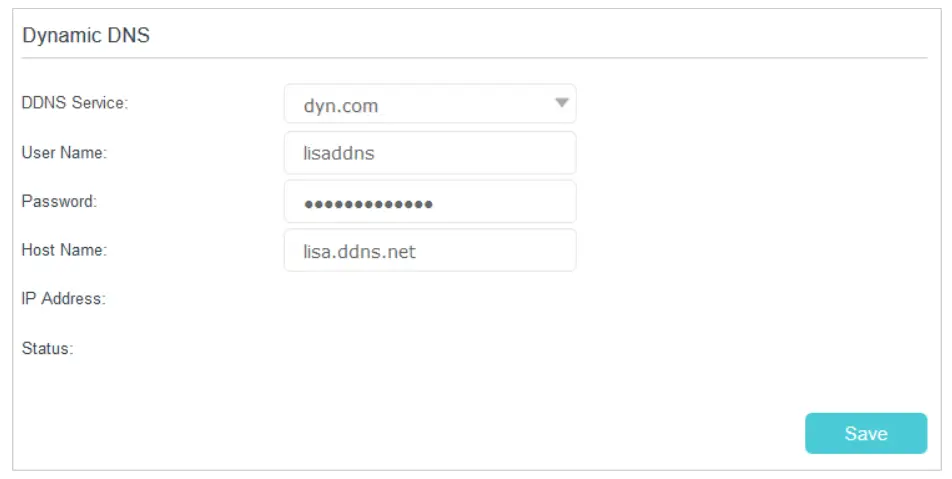 4 Enter the username, password and host name (domain name) of the account (such as lisa.ddns.net).5 Click Save.
4 Enter the username, password and host name (domain name) of the account (such as lisa.ddns.net).5 Click Save.
Administrate Your Network
This chapter introduces how to view basic information, change the system settings and administrate your modem router’s network.This chapter contains the following sections:
• View Basic Information• Set System Time• Back up and Restore Configuration Settings• Change the Administrator Account• Remote Management• System Log
11. 1. View Basic Information
11 1 1 View System Information
1 Visit http://tplinkmodem.net, and log in with the username (admin) and password (admin or the one customized by you).2 Go to Advanced > System Tools > System Information page, then you can view the system information.
11 1 2 View Device Information
1 Visit http://tplinkmodem.net, and log in with the username (admin) and password (admin or the one customized by you).
2 Go to Advanced > System Tools > Device Information page, then you can view the device information.
11. 1. 3. View Connection Status
1 Visit http://tplinkmodem.net, and log in with the username (admin) and password (admin or the one customized by you).
2 Go to Advanced > System Tools > Connection Status page, then you can view the information of startup procedure, downstream bonded channels, upstream bonded channels, and time information.
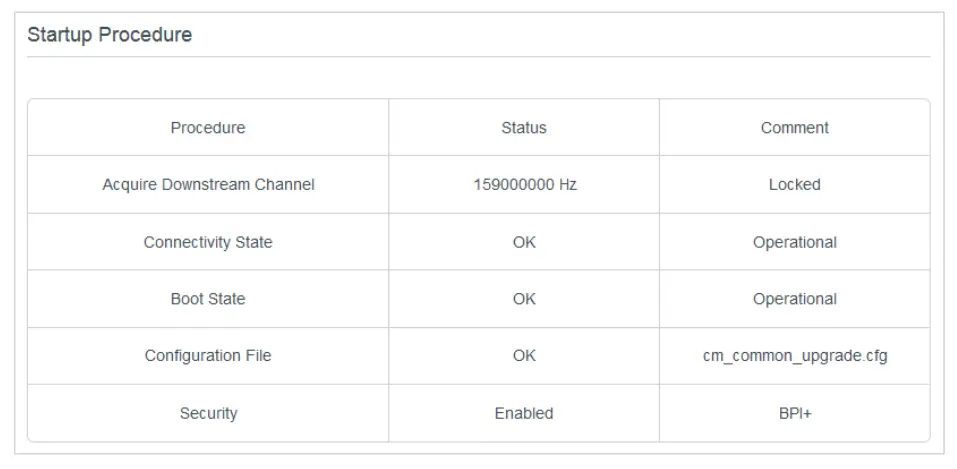


11. 2. Set System Time
System time is the time displayed while the modem router is running. The system time you configure here will be used for other time-based functions like Parental Control. You can manually set how to get the system time.Follow the steps below to set your system time.1 Visit http://tplinkmodem.net, and log in with the username (admin) and password(admin or the one customized by you).2 Go to Advanced > System Tools > Time Settings page.
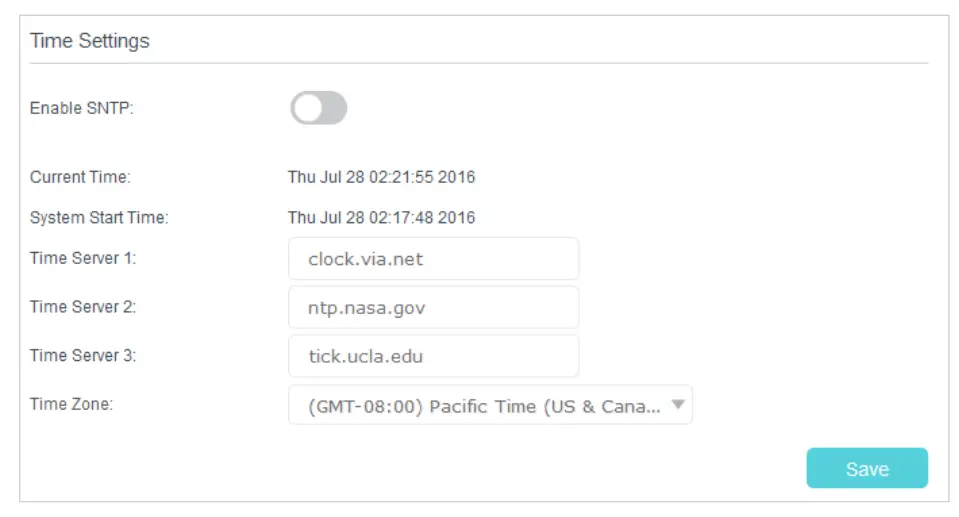
3 Select Enable SNTP.4 Enter the IP address or domain name of Time Server 1, Time Server 2 or Time Server3, and the router will get the time from the NTP Server automatically. In addition, the router has some common built-in NTP Servers that will synchronize automatically once it connects to the Internet.5 Select your local time zone from the Time Zone drop-down list.6 Click Save.
11. 3. Back up and Restore Configuration Settings
The configuration settings are stored as a configuration file in the router. You can back up the configuration file to your computer for future use and restore the modem router to a previous settings from the backup file when needed. Moreover, if needed you can erase the current settings and reset the modem router to the default factory settings.
To back up configuration settings1 Visit http://tplinkmodem.net, and log in with the username (admin) and password (admin or the one customized by you).2 Click Advanced > System Tools > Backup & Restore page.3 Click Backup to save a copy of the current settings to your local computer. A conf. bin file will be stored to your computer.
To restore configuration settings1 Visit http://tplinkmodem.net, and log in with the username (admin) and password (admin or the one customized by you).2 Click Advanced > System Tools > Backup & Restore page.

3 Click Browse to locate the previous backup configuration file, and click Restore.4 Wait for the restoring and then the modem router will automatically reboot.
To reset the modem router to factory default settings1 Visit http://tplinkmodem.net, and log in with the username (admin) and password (admin or the one customized by you).2 Click Advanced > System Tools > Backup & Restore page.3 Click Reset to reset the modem router.4 Wait for the resetting and then the modem router will automatically reboot.Note:1. During the resetting process, do not turn off the modem router.2. We strongly recommend you back up the current configuration settings before resetting the modem router.
11 4 Change the Administrator Account
Admin account is used to log in to the modem router’s web management page. You can change it on the web management page.1 Visit http://tplinkmodem.net, and log in with the username (admin) and password (admin or the one customized by you).2 Go to Advanced > System Tools> Administrator page. Locate the Account Management section.

3 Enter the old password. Enter the new password and enter again to confirm.4 Click Save to make the settings effective.
11 5 Remote Management
By default, the remote devices are not allowed to manage the modem router from the Internet.Follow the steps below to allow remote devices to manage the modem router.1 Visit http://tplinkmodem.net, and log in with the username (admin) and password (admin or the one customized by you).2 Go to Advanced > System Tools> Administrator page. Locate the Remote Config Management section.

3 Select the checkbox to enable Remote Config Management.4 Click Save to make the settings effective. Now, all devices on the Internet can log in to http://modem router’s WAN IP address : 8080 (such as http://113.116.60.229:8080) to manage the modem router.Tips:1. You can find the WAN IP address of the router on Basic > Network Maps > Internet.2. The router’s WAN IP is usually a dynamic IP. Please refer to Set Up a Dynamic DNS Service Account if you want to log in to the router through a domain name.3. If you don’t want devices on the public network to ping the WAN IP address of the router, enable WAN Blocking on this page.

11 6 System Log
System Log can help you know what happened to your modem router, facilitating you to locate the malfunctions. For example, when your modem router does not work properly, you will need to save the system log and send it to the technical support for troubleshooting.1 Visit http://tplinkmodem.net, and log in with the username (admin) and password (admin or the one customized by you).2 Click Advanced > System Tools > Event Log page, then you can view the system logs.

Click Refresh Log to refresh the log list.Click Clear Log to delete all the system logs.
Appendix: Troubleshooting
T1 How do I restore my modem router’s configuration to its factory default settings?There are two ways to reset the modem router:• Method 1: Use the Reset button. For details, refer to the related button description.• Method 2: Use the Backup & Restore page. For details, refer to the instructions in To reset the modem router to factory default settings.Note: Once the modem router is reset, the current configuration settings will be lost and you will need to reconfigure the modem router.
T2 What can I do if I forgot my password?
Web management page password:Restore the modem router to its factory default settings and use the default admin (all lowercase) for both username and password to log in.
Wireless network password:1 The default Wireless Password/PIN is printed on the product label of the modem router.2 If the default wireless password has been changed, log into the modem router’s web management page and go to Basic > Wireless to retrieve or reset your password.Guest network password:Log into the web management page and go to Basic > Guest Network to retrieve or reset the password.
T3 What can I do if I cannot log in to the modem router’s web management page?• Make sure the modem router connects to the computer correctly and the corresponding LED indicator(s) light up.• Make sure the IP address of your computer is configured to obtain an IP address automatically and obtain DNS server address automatically.• Make sure the default access http://tplinkmodem.net or http://192.168.1.1 is correctly input.• Check your computer’s settings:1 ) Go to Start > Control Panel > Network and Internet, and click View network status and tasks;2 ) Click Internet Options on the bottom left;3 ) Click Connections, select Never dial a connection;

4 ) Click LAN settings, deselect the following three options and click OK;

5 ) Go to Advanced > Restore advanced settings, click OK to save the settings.
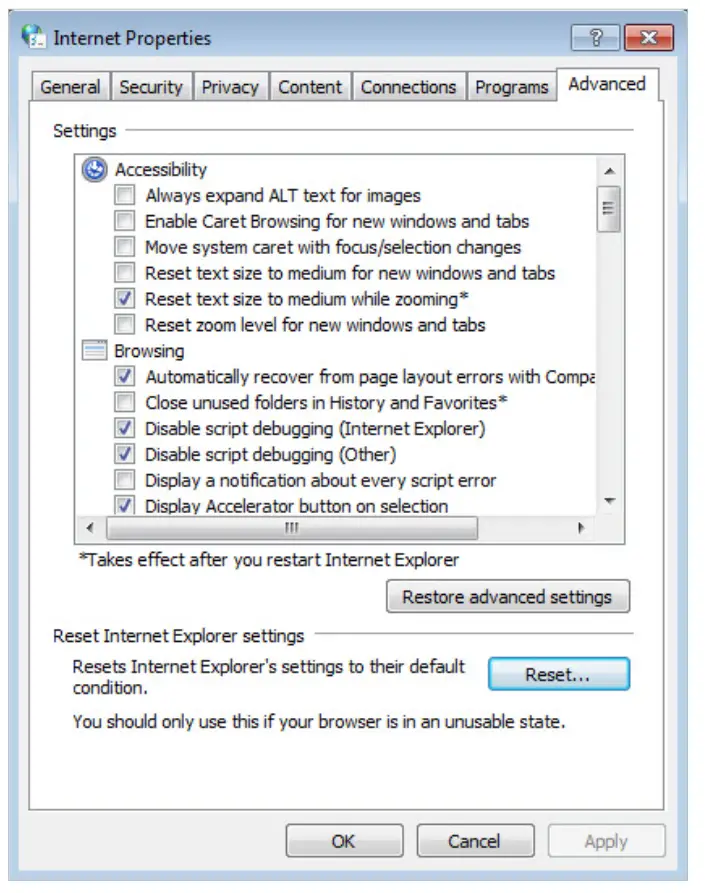
• Change a web browser or computer and log in again.• Reset the modem router to factory default settings.Note: You’ll need to reconfigure the modem router to surf the Internet once the modem router is reset. Open a web browser and log in again. If login fails, please contact the technical support.
T4 What can I do if I cannot access the Internet?
1 Check to see if all the connectors are connected well, including the coaxial cable, Ethernet cables and power adapter.2 Check to see if you can log in to the web management page of the modem router. If you can, try the following steps. If you cannot, please set your computer by referring to T3 and then try to see if you can access the Internet. If the problem persists, please go to the next step.3 Consult your ISP and make sure the modem router is activated.4 Refer to T5 to clone the MAC address.5 If you still cannot access the Internet, please restore your modem router to its factory default settings and reconfigure your modem router by following the instructions in Quick Start.6 Please contact our Technical Support if the problem still exists.
T5 How to configure MAC Clone?
You can manually change the MAC address of the modem router. It is helpful when your Internet access account provided by your ISP is bound to one specific MAC address, in other words, your ISP just permits only one computer with the authenticated MAC address to access the Internet. In this case, you can use MAC Clone to allow more computers to access the Internet via the same account.1 Visit http://tplinkmodem.net, and log in with the username (admin) and password (admin or the one customized by you).2 Go to Advanced > Network > WAN page. Locate the Connection Settings section.

• If you are using the computer with the authenticated MAC address to access the modem router, please select Use Computer MAC Address.• If you know the authenticated MAC address, please select Use this MAC Address and then enter the address.3 Click Apply to make the settings effective.
T6 What can I do if I cannot find my wireless network or I cannot connect the wireless network?
If you fail to find any wireless network, follow the steps below:1 Make sure the wireless function is enabled if you’re using a laptop with built-in wireless adapter. You can refer to the relevant document or contact the laptop manufacturer.2 Make sure the wireless adapter driver is installed successfully and the wireless adapter is enabled. You can refer to the relevant document or contact the wireless adapter manufacturer.>If you can find other wireless network except your own, follow the steps below:1 Check the Wi-Fi LED indicator on your wireless router/modem;2 Make sure your computer/device is still in the range of your router/modem, move closer if it is currently too far away;3 Go to Basic > Wireless page, and check the wireless settings, double check your Wireless Name and the SSID is not hidden.4 Connect to wireless network.> If you can find your wireless network but fail to connect, follow the steps below:1 Authenticating problem, password mismatch.1 ) Sometimes it will ask you to type in a PIN number when you connect to the wireless network for the first time. This PIN number is different from the Wireless Password/Network Security Key, usually you can only find it on the label of your modem router.
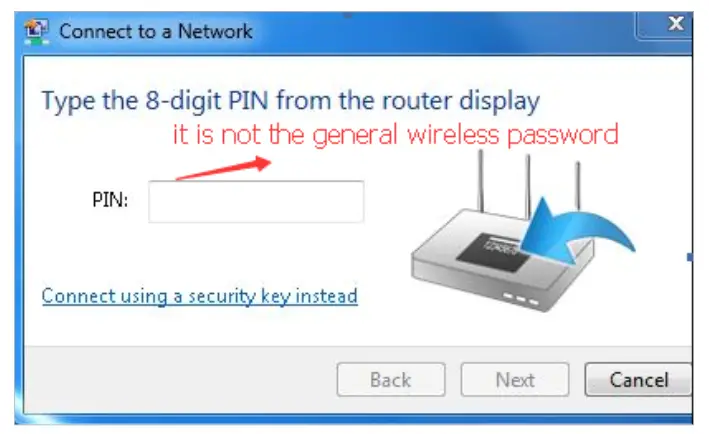
2 ) If you cannot find the PIN or PIN failed, you may choose “Connecting using a security key instead”, and then type in the Network Security Key/Wireless Password;

3 ) If it continues to saying network security key mismatch, it is suggested to confirm the wireless password on your modem router.
Note: Wireless password/Network Security Key is case sensitive.

4 ) Connect to wireless network.2 Windows was unable to connect to XXXX /Cannot join this network/Taking longer than usual to connect to this network.1 ) Check the wireless signal strength of your network, if it is weak (1~3 bars), please move the router closer and try again;2 ) Change the wireless Channel of the router to 1,6,or 11 to reduce interference from other networks;3 ) Re-install or update the driver for your wireless adapter of the computer;4 ) Connect to wireless network.T7 How can I change my computer‘s setting to obtain an IP address automatically?To change the computer’s network settings, follow the steps below.• For MAC OS X:1 ) Click the Apple icon, and select System Preferences from the drop-down list.2 ) Click the Network icon.3 ) Select Ethernet (for wired connection) or Wi-Fi (for wireless connection) in the left panel, then click Advanced.4 ) Click TCP/IP.5 ) From the Configure IPv4 drop-down list, select Using DHCP.6 ) Click OK.• For Windows 7/8/8 1/10:1 ) Right-click the Network icon on the system tray and select Open Network and Sharing Center > Change adapter settings.2 ) Right-click your network connection (wired or wireless) and select Properties.3 ) Double-click Internet Protocol Version 4 (TCP/IPv4).
4 ) Select both Obtain an IP address automatically and Obtain DNS server address automatically, then click OK.5 ) Click OK again to save your configuration.• For Windows XP:1 ) Right-click the Network icon on the system tray and select Open Network Connections.2 ) Right-click your network connection (wired or wireless) and select Properties.3 ) Double-click Internet Protocol (TCP/IP).4 ) Select both Obtain an IP address automatically and Obtain DNS server address automatically, then click OK.5 ) Click OK again to save your configuration.
COPYRIGHT & TRADEMARKS Specifications are subject to change without notice. is a registered trademark of TP-LINK TECHNOLOGIES CO., LTD. Other brands and product names are trademarks or registered trademarks of their respective holders.
No part of the specifications may be reproduced in any form or by any means or used to make any derivative such as translation, transformation, or adaptationwithout permission from TP-LINK TECHNOLOGIES CO., LTD. Copyright © 2016 TP-LINK TECHNOLOGIES CO., LTD. All rights reserved.
This equipment has been tested and found to comply with the limits for a Class B digital device, pursuant to part 15 of the FCC Rules. These limits are designed to provide reasonable protection against harmful interference in a residential installation. This equipment generates, uses and can radiate radio frequency energy and, if not installed and used in accordance with the instructions, may cause harmful interference to radio communications. However, there is no guarantee that interference will not occur in a particular installation. If this equipment does cause harmful interference to radio or television reception, which can be determined by turning the equipment off and on, the user is encouraged to try to correct the interference by one or more of the following measures:• Reorient or relocate the receiving antenna.• Increase the separation between the equipment and receiver.• Connect the equipment into an outlet on a circuit different from that to which the receiver is connected.• Consult the dealer or an experienced radio/ TV technician for help.This device complies with part 15 of the FCC Rules. Operation is subject to the following two conditions:1 ) This device may not cause harmful interference.2 ) This device must accept any interference received, including interference that may cause undesired operation.Any changes or modifications not expressly approved by the party responsible for compliance could void the user’s authority to operate the equipment.
Note: The manufacturer is not responsible for any radio or TV interference caused by unauthorized modifications to this equipment. Such modifications could void the user’s authority to operate the equipment.
FCC RF Radiation Exposure StatementThis equipment complies with FCC RF radiation exposure limits set forth for an uncontrolled environment. This device and its antenna must not be co-located or operating in conjunction with any other antenna or transmitter.“To comply with FCC RF exposure compliance requirements, this grant is applicable to only Mobile Configurations. The antennas used for this transmitter must be installed to provide a separation distance of at least 20 cm from all persons and must not be colocated or operating in conjunction with any other antenna or transmitter.”
Safety Information• When product has power button, the power button is one of the way to shut off the product; when there is no power button, the only way to completely shut off power is to disconnect the product or the power adapter from the power source.• Don’t disassemble the product, or make repairs yourself. You run the risk of electric shock and voiding the limited warranty. If you need service, please contact us.• Avoid water and wet locations.• Adapter shall be installed near the equipment and shall be easily accessible.• The plug considered as disconnect device of adapter.• The product should be connected to cable distribution system that grounded (earthed) in accordance with ANSI/NFPA 70, the National Electrical Code (NEC), in particular Section 820.93 – Grounding of Outer Conductive Shield of a Coaxial Cable.
Explanation of the symbols on the product label
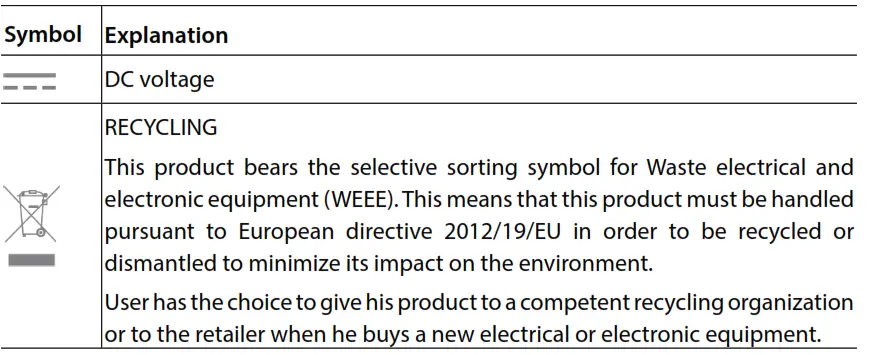
Archer CR500 Manual [DOCSIS 3.0 Cable Modem/Router] – Archer CR500 Manual [DOCSIS 3.0 Cable Modem/Router] –
[xyz-ips snippet=”download-snippet”]


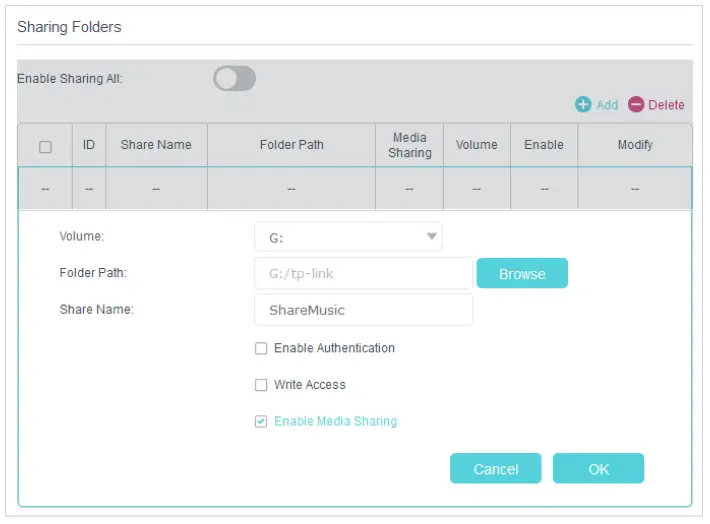
 3 ) Open the uncompressed folder, then click TP-LINK USB Printer Controller Setup (for Windows users) or TP-Link UDS Printer Controller Installer (for Mac users) to install the utility.
3 ) Open the uncompressed folder, then click TP-LINK USB Printer Controller Setup (for Windows users) or TP-Link UDS Printer Controller Installer (for Mac users) to install the utility.